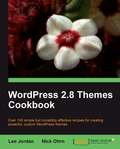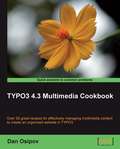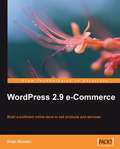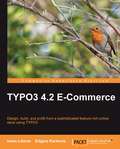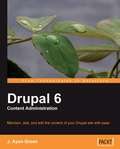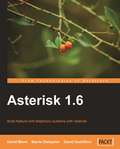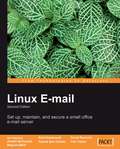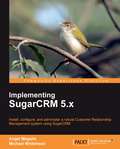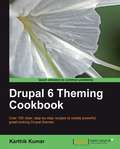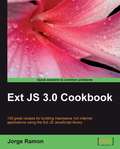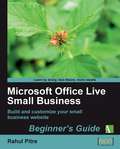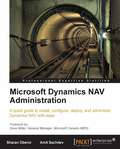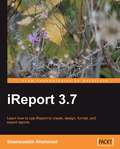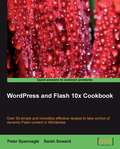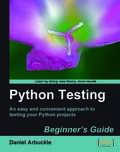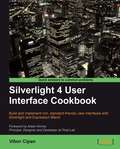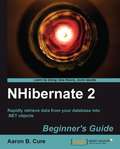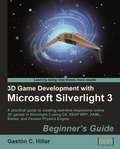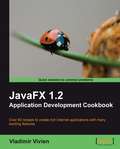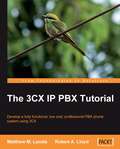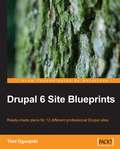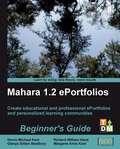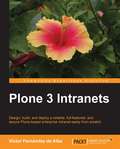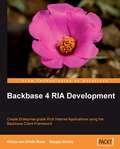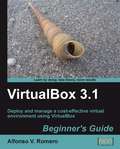- Table View
- List View
WordPress 2.8 Themes Cookbook
by Nick OhrnEach recipe comprises step-by-step instructions followed by the analysis of what was done in each task and other useful information. The book is designed so that you can read it chapter by chapter, or you can look at the list of recipes and refer to them in no particular order. There are plenty of useful screenshots to make learning easier for you. This book is for WordPress developers who want to create powerful themes for their blogs and web sites to impress and influence visitors. This book expects working knowledge of the WordPress platform. Knowledge of HTML and CSS would also be useful.
TYPO3 4.3 Multimedia Cookbook
by Dan OsipovThe TYPO3 Multimedia Cookbook presents over 50 effective recipes for managing multimedia in your TYPO3 site. Each recipe comprises step-by-step instructions followed by the analysis of what was done in each task and any relevant information. The book is designed so that you can refer to it chapter by chapter, or you can look at the list of recipes and read them in no particular order. The book has recipes to tackle specific problems along with detailed explanations that will help you to customize the recipes as per your individual needs. Since learning comes from doing, the reader is encouraged to follow along with the examples using the book as a practical guide. This book is for anyone who is looking for effective systems for managing multimedia content. You will find this book interesting if you are running, or starting, web sites rich in multimedia content. This book assumes some prior knowledge about TYPO3, which is available either from official documentation, or other books on this topic.
WordPress 2.9 E-Commerce
by Brian BondariThis book provides an easy to understand, step-by-step approach to installing, configuring, and using WP e-Commerce to run your online store. We will construct an example store in the book with enough information and flexibility to adapt the store to your specific needs. This book is for you, if you are interested in using WordPress as the basis for a store that can sell physical items, downloads, or services. It is ideal for a sole proprietor or small business owner with only basic, in-house technical skills. Some prior knowledge of WordPress will help, but is not required. No knowledge of PHP is expected, but it will also be helpful.
TYPO3 4.2 E-Commerce
by Edgars KarlsonsThis is a fast-paced tutorial focusing on creating an online store. It walks in detail through development of a sample website, illustrating each step with screenshots and explanation. The cumbersome and time-consuming task of developing and customizing a TYPO3 e-commerce site will be a smooth sail with this book. If you want to create a captivating online shop using TYPO3 and optimize your profit, this book is for you. Some knowledge of TYPO3, PHP, and TypoScript is required.
Drupal 6 Content Administration
by J. Ayen GreenThis is a fun, informative, hands-on learning guide that uses an actual case study. In an interactive and informal manner, this guide presents purposeful examples that continue to build on each other. Clear, concise instructions and practical examples mean you can learn quickly how to take care of the content in your Drupal site. This book is designed for those who run the site day-to-day but didn't set it up, and aren't necessarily that well versed in Drupal or web technologies. You could be a content editor, proofreader, graphic artist, feature editor, or anyone else concerned with managing content on a Drupal installation.
Asterisk 1.6
by Barrie Dempster David GomillionThe book offers readers both a detailed description as well as step by step instructions on deploying software solutions as well as Asterisk configurations. Screenshots are provided in sections to give a visual perspective of the instructions. For Asterisk configurations actual sample code is listed in the book which can be directly inserted into your Asterisk solution.This book is aimed at anyone who is interested in building a powerful telephony system using the free and open source application, Asterisk, without spending many thousands of dollars buying a commercial and often less flexible system. This book is suitable for the novice and those new to Asterisk and telephony. Telephony or Linux experience will be helpful, but not required.
Linux Email
by Alistair Mcdonald Carl TaylorThe book takes a practical, step-by-step approach to working with email servers. It starts by establishing the basics and setting up a mail server. Then you move to advanced sections like webmail access, security, backup, and more. You will find many examples and clear explanations that will facilitate learning. This book is aimed at technically confident users and new and part-time system administrators in small businesses, who want to set up a Linux-based email server without spending a lot of time becoming expert in the individual applications. Basic knowledge of Linux is expected.
Implementing SugarCRM 5.x
by Angel MaganaThe book works from the SugarCRM basics right up to advanced features in a clear and friendly way. It follows a combination of theoretical discussions relating to varying business needs and the manner in which CRM technology can address them. By helping you clarify your business goals the book enables you to build a CRM system to support your business needs. If you are a small-medium business owner/manager with reasonable IT skills, a system implementer, or a system administrator who wants to implement SugarCRM for yourself either as a first CRM or as a replacement for existing solutions, this book is for you. Existing SugarCRM users who want to broaden their understanding of the topic will find this book valuable too. No programming knowledge is required to use this book to implement, customize, and use SugarCRM.
Drupal 6 Theming Cookbook
by Karthik KumarWritten in cookbook style, this book offers solutions to all common theme design problems through recipes. Each recipe contains step-by-step instructions followed by the analysis of what was done in each task and other useful information. The book is designed so that you can read it chapter by chapter, or you can look at the list of recipes and refer to them in no particular order. This book is written for Drupal developers who want to refresh the look and feel of their sites. If you are a Drupal site administrator who is looking to go beyond the basics and customize the presentational aspects of your Drupal site, then this book is for you. It assumes that readers are familiar with rudimentary PHP and acquainted with Drupal installation and general usage. Readers are also expected to have knowledge of CSS and XHTML.
Ext JS 3.0 Cookbook
by Jorge RamonThe Ext JS Cookbook contains step-by-step instructions for Ext JS users to build desktop-style interfaces in their own web applications. The book is designed so that you can refer to it chapter by chapter, or you can look at the list of recipes and read them in no particular order. The Ext JS Cookbook is for Ext JS users who want a book of useful techniques, with explanations, that they can refer to and adapt to their purposes. Developers who are already familiar with Ext JS will find practical guidance and numerous examples covering most of the library's features and components that can be used as a solid foundation to build upon when creating rich internet applications.
Microsoft Office Live Small Business: Beginner’s Guide
by Rahul PitreA tutorial in the Beginner's Guide series, offering the reader step-by-step instructions on building and customizing their MOLSB web site from scratch. This book is also packed with tips, tricks, and best practices. Small-business owners who want to build and customize their business web sites on Microsoft's free-to-use platform. No technical knowledge is required.
Microsoft Dynamics NAV Administration
by Amit Sachdev Sharan OberoiThis book is a tutorial guide that illustrates the steps needed to install, configure, deploy, and administer Dynamics NAV. It shows you how to get started with Dynamics NAV and then gradually explains other admin tasks such as backing up and performance tuning, using practical examples. If you want to get started in administering Dynamics NAV, this book is for you. Readers do not need any previous experience with Dynamics NAV.
iReport 3.7
by Shamsuddin AhammadStep-by-step example-driven tutorials make this book very easy to follow. Practical, realistic business examples, many relevant screenshots, and simple discussion of prior concepts help readers to understand from the simplest to the most complex concepts. This book is for business intelligence reporting tool users and developers who have working experience in Java but are new to iReport. The book covers from developing a simple report to charting and producing summary reports in iReport, so it is suitable both for the initial learners and experts who produce extensive reports for business applications.
Wordpress and Flash 10x Cookbook
by Peter Spannagle Sarah SowardThis book consists of a series of easy-to-follow recipes. Each recipe stands on its own, so you can open the book to any recipe and complete it without going through the previous recipes. You can work through the book from start to end or just choose the recipes most applicable to your needs and situation. The book presents recipes of varying difficulty levels so that there is something for everyone from a beginner to an advanced WordPress user. Detailed screenshots, code examples, and links to additional resources supplement the concise instructions. If you are a Wordpress user interested in creating multimedia-rich websites and blogs using Flash then this book is perfect for you. This book caters for site administrators and web developers, who have experience using Flash aand Wordpress.
Python Testing: Beginner's Guide
by Daniel ArbuckleThe book begins with the very foundations of automated testing, and expands on them until the best-practice tools and techniques are fully covered. New concepts are illustrated with step-by-step hands-on exercises. Testing will be easier and more enjoyable with this beginner's guide. If you are a Python developer and want to write tests for your applications, this book will get you started and show you the easiest way to learn testing. You need to have sound Python programming knowledge to follow along. An awareness of software testing would be good, but no formal knowledge of testing is expected nor do you need to have any knowledge of the libraries discussed in the book.
Silverlight 4 User Interface Cookbook
by Vibor CipanWritten in a Cookbook style, this book offers learning and techniques through recipes. It contains step-by-step instructions for designers and developers who want to learn about how to design and implement numerous user interface patterns with Silverlight. It will take you a step further by providing you with professional and proven user interface and user experience guidelines wherever possible. The book is designed in such a way that you can explore it chapter-by-chapter, or read it in any order. If you are a developer or designer who knows the basics of Silverlight, has a smattering of C# and XAML, and wants to build applications with elegant and attractive interfaces, then this book is for you.
NHibernate 2 Beginner's Guide
by Aaron CureThis is a beginner's guide to NHibernate that starts from ground zero. Successive chapters build upon earlier concepts, while the sample code presents various ways to accomplish typical data access tasks. Within a few chapters you have a running application using NHibernate to retrieve and store data. We examine all of the topics required to get a functional data access layer implemented by writing the least amount of code possible, presenting options along the way to handle particular edge cases or situations as they arise. When you have completed the various exercises you will have running data-bound desktop and web applications, as well as an understanding of how to implement NHibernate in your own applications. This book is for new and seasoned developers of .NET web or desktop applications who want a better way to access database data. It is a basic introduction to NHibernate, with enough information to get a solid foundation in using NHibernate. Some advanced concepts are presented where appropriate to enhance functionality or in situations where they are commonly used.
3D Game Development with Microsoft Silverlight 3: Beginner's Guide
by Gaston C. HillarThis book takes a step-by-step approach to building a complete interactive 3D game using Silverlight and enhancing it through its related technologies. The book focuses on practical examples and has a friendly approach, with the opportunity to learn by experiment and play. It uses illustrations, screenshots, and interactive experiences to understand the most complex topics related to the 3D scenes. This book is designed primarily for C# developers with basic knowledge of the Visual Studio IDE who want to develop online 3D games using Silverlight or create interactive 3D scenes for a web site with animated models. No prior experience in 3D programming, 3D animation, or Silverlight is required. The book is also aimed at 3D developers who want to improve their online content, offering innovative 3D models in action.
JavaFX 1.2 Application Development Cookbook
by Vladimir VivienThis book is a comprehensive collection of recipes that elaborate on known use cases. You will find an organized step-by-step procedure to accomplish each task followed by detailed explanations to better understand how and why each step was undertaken, and many links to online references and other related sections in the book that supplement the subject in question. The book is written so that you can work through the recipes in order or go straight to the recipes that interest you; where a recipe depends on other recipes they are clearly referenced. If you are a Java developer, Rich Internet Application content developer, or graphic designer who wants to build RIAs featuring animations, videos, and other feature-rich content, this book is for you. Knowledge of Java, JavaScript, and JavaFX components is not essential, but will help you exploit this book to your advantage.
The 3CX IP PBX Tutorial
by Matthew M. Landis Robert LloydA hands-on and practical tutorial that shows administrators how to implement and use 3CX and its range of functionality. Using real world experiences from the authors, you will learn tricks and tips that will help you develop and optimize your 3CX system. This book is for beginners who know nothing about 3CX or VoIP. It will guide them to set up a complete system. Advanced users will also gain insight from information on real-world hardware and software tips and tricks.
Drupal 6 Site Blueprints
by Timi OgunjobiThe hands-on example projects in this book are based on fictitious web site development briefs, and they illustrate practical ways of applying Drupal. The book dives straight into the process of constructing the featured projects. A chapter is dedicated to each example web site project. Each chapter contains a fictitious brief from which we derive the list of core and contributed modules that we will require to implement the project. Then each chapter progresses into step-by-step instructions for building the web project, aided by the extensive use of screenshots. When you have completed each project, you will have the knowledge and confidence to apply the techniques you have learned to create your own custom web application. This book is for anybody who wants to build a range of Drupal sites, and see how to apply the many available Drupal plugins and features in different scenarios. If you develop Drupal sites professionally, or would like to try building web sites as a freelancer, this is a great book to help you get started.
Mahara 1.2 E-Portfolios: Beginner's Guide
by Glenys Gillian Bradbury Derrin Michael KentThis book will provide you with step-by-step instructions to get started with Mahara and create an impressive electronic portfolio. The book is packed with many useful examples and screenshots for easy and quick learning. Pick this book up if you want to get started with Mahara. This book is for you if: You are a student/learner wanting to maintain online documentation of your projects and share it with a particular teacher/trainer for feedback, You are a teacher wanting to set up an e-portfolio for your students in order to encourage and advance personalized and reflective learning, You are a professional wanting to share your journals and project documents with your team by sharing your existing knowledge and creating new knowledge in communities of professional practice, No previous experience of Mahara is required.
Plone 3 Intranets
by Victor Fernandez AlbaThis is a step-by-step guide, from installing your first Plone instance to deploying your intranet. Each chapter will show you an essential aspect that your intranet should have. However, each chapter is isolated enough to serve as a reference manual for later use. The book is packed with examples and useful screenshots for easy learning. This book is for anyone who needs to build an intranet with no limits on capabilities or features. Even if you don't have previous CMS experience or programming skills, this book is for you. Targeted at beginners with no previous experience with Plone, this book will teach you step by step and at the end you should have a full-featured, reliable, and secure intranet.
Backbase 4 RIA Development
by Ghica van Emde Boas Sergey IlinskyThis is a practical book, where every example is tested and all source code is available with the book. Each chapter ends with work on a sample application using the new things learned. At the end of the book there is a complete, usable Travel Blog application. This book is for web developers who want to develop applications using the Backbase Client Framework. It may also be interesting for web developers and web application architects who want to know more about XML-based web application architectures.
VirtualBox 3.1: Beginner's Guide
by Alfonso V. RomeroThis beginner's guide consists of comprehensive explanation, appropriate screenshots, tips, tricks, and best practices. It offers step-by-step instructions on building your own virtual environment from scratch, supported by the reasoning behind what you do. If you are a System Administrator who has to set up a virtual machine and want to use an open source tool to do it this book will prove invaluable. No prior knowledge of VirtualBox is required, but you should have experience with general system administration.
